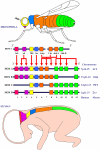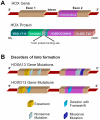HOX genes: seductive science, mysterious mechanisms
- PMID: 16457401
- PMCID: PMC1891803
HOX genes: seductive science, mysterious mechanisms
Erratum in
- Ulster Med J. 2006 May;75(2):135
Abstract
HOX genes are evolutionarily highly conserved. The HOX proteins which they encode are master regulators of embryonic development and continue to be expressed throughout postnatal life. The 39 human HOX genes are located in four clusters (A-D) on different chromosomes at 7p15, 17q21 [corrected] 12q13, and 2q31 respectively and are assumed to have arisen by duplication and divergence from a primordial homeobox gene. Disorders of limb formation, such as hand-foot-genital syndrome, have been traced to mutations in HOXA13 and HOXD13. Evolutionary conservation provides unlimited scope for experimental investigation of the functional control of the Hox gene network which is providing important insights into human disease. Chromosomal translocations involving the MLL gene, the human homologue of the Drosophila gene trithorax, create fusion genes which exhibit gain of function and are associated with aggressive leukaemias in both adults and children. To date 39 partner genes for MLL have been cloned from patients with leukaemia. Models based on specific translocations of MLL and individual HOX genes are now the subject of intense research aimed at understanding the molecular programs involved, and ultimately the design of chemotherapeutic agents for leukaemia. Investigation of the role of HOX genes in cancer has led to the concept that oncology may recapitulate ontology, a challenging postulate for experimentalists in view of the functional redundancy implicit in the HOX gene network.
Figures



Similar articles
-
The pathophysiology of HOX genes and their role in cancer.J Pathol. 2005 Jan;205(2):154-71. doi: 10.1002/path.1710. J Pathol. 2005. PMID: 15643670 Review.
-
Limb malformations and the human HOX genes.Am J Med Genet. 2002 Oct 15;112(3):256-65. doi: 10.1002/ajmg.10776. Am J Med Genet. 2002. PMID: 12357469 Review.
-
Complete array of HOX gene expression by RQ-PCR.Methods Mol Biol. 2009;538:369-93. doi: 10.1007/978-1-59745-418-6_19. Methods Mol Biol. 2009. PMID: 19277582
-
The bithorax complex of Drosophila an exceptional Hox cluster.Curr Top Dev Biol. 2009;88:1-33. doi: 10.1016/S0070-2153(09)88001-0. Curr Top Dev Biol. 2009. PMID: 19651300 Review.
-
Common functions of central and posterior Hox genes for the repression of head in the trunk of Drosophila.Development. 2008 Jan;135(2):291-300. doi: 10.1242/dev.009662. Epub 2007 Dec 12. Development. 2008. PMID: 18077590
Cited by
-
Advancements in Genetic Marker Exploration for Livestock Vertebral Traits with a Focus on China.Animals (Basel). 2024 Feb 11;14(4):594. doi: 10.3390/ani14040594. Animals (Basel). 2024. PMID: 38396562 Free PMC article. Review.
-
HOXA7, HOXA9, and HOXA10 are differentially expressed in clival and sacral chordomas.Sci Rep. 2017 May 17;7(1):2032. doi: 10.1038/s41598-017-02174-5. Sci Rep. 2017. PMID: 28515451 Free PMC article.
-
Homeobox Transcription Factors Are Required for Fungal Development and the Suppression of Host Defense Mechanisms in the Colletotrichum scovillei-Pepper Pathosystem.mBio. 2021 Aug 31;12(4):e0162021. doi: 10.1128/mBio.01620-21. Epub 2021 Aug 24. mBio. 2021. PMID: 34425710 Free PMC article.
-
Nucleosome Clutches are Regulated by Chromatin Internal Parameters.J Mol Biol. 2021 Mar 19;433(6):166701. doi: 10.1016/j.jmb.2020.11.001. Epub 2020 Nov 9. J Mol Biol. 2021. PMID: 33181171 Free PMC article.
-
Endocrine disrupting chemical, bisphenol-A, induces breast cancer associated gene HOXB9 expression in vitro and in vivo.Gene. 2016 Sep 30;590(2):234-43. doi: 10.1016/j.gene.2016.05.009. Epub 2016 May 13. Gene. 2016. PMID: 27182052 Free PMC article.
References
-
- Lewis EB. A gene complex controlling segmentation in Drosophila. Nature. 1978;276(5688):565–70. - PubMed
-
- Wilson R, Ainscough R, Anderson K, Baynes C, Berks M, Bonfield J, Burton J, Connell M, Copsey T, Cooper J, et al. 2.2 Mb of contiguous nucleotide sequence from chromosome III of C. elegans. Nature. 1994;368(6466):32–38. - PubMed
-
- Duboule D. The vertebrate limb: a model system to study the Hox/HOM gene network during development and evolution. Bioessays. 1992;14(6):375–84. - PubMed
-
- Lewin B. Genes VII. Oxford: Oxford University Press; 2000. Homeodomains bind related targets in DNA; pp. 660–62.
Publication types
MeSH terms
Substances
LinkOut - more resources
Full Text Sources
Other Literature Sources
Research Materials
